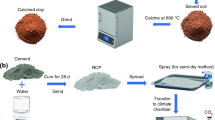Abstract
Three different types and sizes of coarse aggregate were chosen, and the alternating current (AC) impedance of cement paste samples with and without aggregate was measured at different curing ages. Based on Song’s equivalent circuit model, the electrical properties from the AC impedance results were obtained, and the resistance of connected pores RCCP was used to characterize the microstructure of the interfacial transition zone (ITZ). The results show that the RCCP of concrete sample with aggregate is lower than that of cement paste sample, which indicates that the introduction of aggregate in cement paste makes the ITZ porous. Furthermore, for the same type of aggregate, an increase in particle size leads to a more porous ITZ, which accounts for the “water effect” and a larger aggregate would accumulate a thicker water film around it. In addition, for the same size of aggregate, the physical interaction between aggregate and cement paste is dominant in early age, and the microstructure of the ITZ around limestone aggregate is denser, which mainly depends on its rough surface and high water absorption. However, the microstructures of the ITZ around granite and basalt aggregates are denser in later age, which may be due to their higher chemical activity, and the chemical interaction between them and cement paste resulting in the generation of more hydrates. AC impedance spectroscopy thus proves to be powerful for evaluation of the microstructure of the ITZ.
Similar content being viewed by others
References
Scrivener KL. Backscattered Electron Imaging of Cementitious Microstructures: Understanding and Quantification[J]. Cem. Concr. Comp., 2004, 26(8): 935–945
Zhang MH, Gjørv OE. Penetration of Cement Paste into Lightweight Aggregate[J]. Cem. Concr. Res., 1991, 22(1): 47–55
Lo TY, Cui HZ. Spectrum Analysis of the Interfacial Zone of Lightweight Aggregate Concrete[J]. Mater. Lett., 2004, 58(25): 3089–3095
Elsharief A, Cohen MD, Olek J. Influence of Aggregate Size, Water Cement Ratio and Age on the Microstructure of the Interfacial Zone[J]. Cem. Concr. Res., 2003, 33(11): 1837–1849
Cohen, Bentz DP, Snyder KA, et al. Percolation and Pore Structure in Mortars and Concrete[J]. Cem. Concr. Res., 1994, 24(1): 25–37
Chatterji S, Jeffery JW. The Nature of the Bond between Different Types of Aggregates and Cement Paste[J]. Indian Concr. J., 1971, 45(8): 346–349
Brantervik K, Niklasson GA. Circuit Models for Cement Based Materials Obtained from Impedance Spectroscopy[J]. Cem. Concr. Res., 1991, 21(4): 496–508
McCarter WJ. The A.C. Response of Hardened Cement Paste[J]. Cem. Concr. Res., 1990, 20(6): 891–900
Loche JM, Ammar A, Dumargue P. Influence of the Migration of Chloride Ions on the Electrochemical Impedance Spectroscopy of Mortar Paste[J]. Cem. Concr. Res., 2005, 35(9): 1797–1803
Díaz B, Nóvoa XR, Pérez MC. Study of the Chloride Diffusion in Mortar: A New Method of Determining Diffusion Coefficients Based on Impedance Measurements[J]. Cem. Concr. Comp., 2006, 28(3): 237–245
Sánchez I, López MP, Ortega JM, et al. Impedance Spectroscopy: An Efficient Tool to Determine the Non-steady-state Chloride Diffusion Coefficient in Building Materials[J]. Mater. Corros., 2011, 62(2): 139–145
Wu LP, Yan PY. Study of Diffusivity of Chloride Ion on Surface Layer of Concrete Based on AC Impedance Technology[J]. J. Build. Mater., 2013, 16(1): 12–16
Ismail M, Ohtsu M. Corrosion Rate of Ordinary and High-performance Concrete Subjected to Chloride Attack by AC Impedance Spectroscopy [J]. Constr. Build. Mater., 2006, 20(7): 458–469
Andrade C, Soler L, Alonso C, et al. The Importance of Geometrical Considerations in the Measurement of Steel Corrosion in Concrete by Means of AC Impedance[J]. Corros. Sci., 1995, 37(12): 2013–2023
Neithalath N, Jain J. Relating Rapid Chloride Transport Parameters of Concretes to Microstructural Features Extracted from Electrical Impedance[J]. Cem. Concr. Res., 2010, 40(7): 1041–1051
Gu P, Xie P, Beaudoin JJ, et al. A.C. Impedance Spectroscopy (ІІ): Microstructural Characterization of Hydrating Cement-silica Fume System[J]. Cem. Concr. Res., 1993, 23(1): 157–168
Zhong SY, Shi ML, Chen ZY. A study of Polymer-modified Mortars by the AC Impedance Technique[J]. Cem. Concr. Res., 2002, 32(6): 979–982
Yang ZH, Shi ML. AC Impedance Study of the Interface between Cement Paste and Crushed Stone[J]. J. Chongqing Jianzhu Univ., 2000, 22(1): 124–128
Song GL. Equivalence Circuit Model for AC Electrochemical Impedance Spectroscopy of Concrete[J]. Cem. Concr. Res., 2000, 30(11): 1723–1730
Gu P, Xie P, Beaudoin JJ, et al. AC Impedance Spectroscopy (І): A New Equivalent Circuit Model for Hydrated Portland Cement Paste[J]. Cem. Concr. Res., 1992, 22(5): 833–840
Xie P, Gu P, Fu Y, et al. AC Impedance Phenomena in Hydrating Cement Systems: Detectability of the High Frequency Arc[J]. Cem. Concr. Res., 1994, 24(1): 92–94
Christensen BJ, Mason TO, Jennings HM. Influence of Silica Fume on the Early Hydration of Portland Cements using Impedance Spectroscopy [J]. J. Am. Ceram. Soc., 1992, 75(4): 939–945
Tasong WA, Cripps CJ, Lynsdale CJ. Aggregate-cement Chemical Interactions [J]. Cem. Concr. Res., 1998, 28(7): 1037–1048
Author information
Authors and Affiliations
Corresponding author
Additional information
Funded by the National Natural Science Foundations of China (Nos. 51108282 and 51478278) and the Excellent Youth Scholars of University Science and Technology Research of Hebei Province (No. Y2011111)
Rights and permissions
About this article
Cite this article
Kong, L., Hou, L., Wang, Y. et al. Investigation of the interfacial transition zone between aggregate-cement paste by AC impedance spectroscopy. J. Wuhan Univ. Technol.-Mat. Sci. Edit. 31, 865–871 (2016). https://doi.org/10.1007/s11595-016-1460-2
Received:
Accepted:
Published:
Issue Date:
DOI: https://doi.org/10.1007/s11595-016-1460-2




